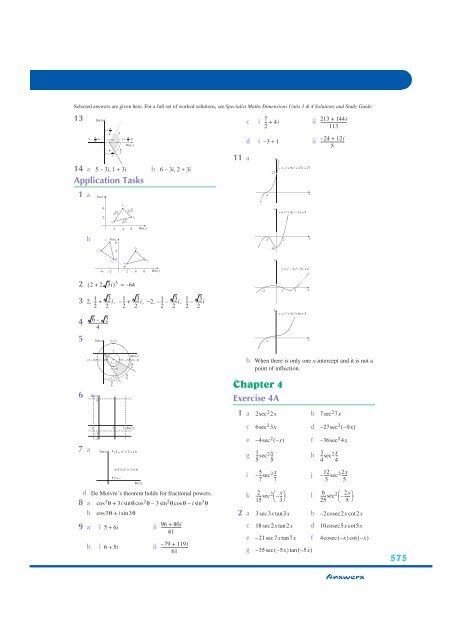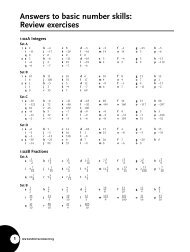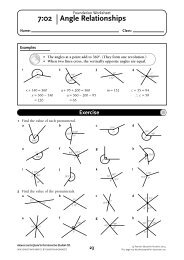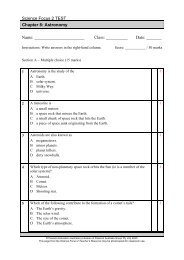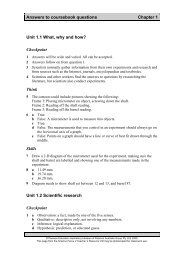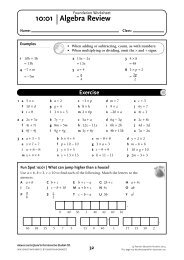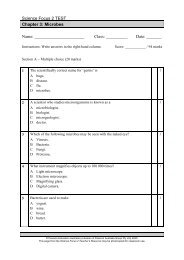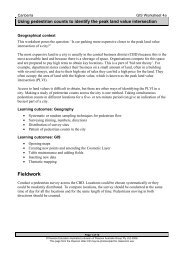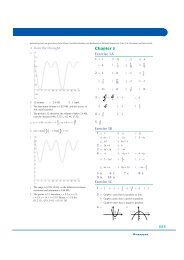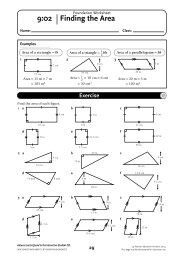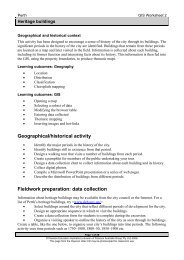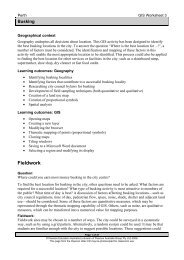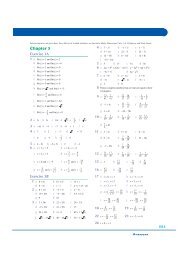575 Answers Chapter 4
575 Answers Chapter 4
575 Answers Chapter 4
Create successful ePaper yourself
Turn your PDF publications into a flip-book with our unique Google optimized e-Paper software.
Selected answers are given here. For a full set of worked solutions, see Specialist Maths Dimensions Units 3 & 4 Solutions and Study Guide.1314 a 5 – 3i, 1 + 3i b 6 – 3i, 2 + 3iApplication Tasks1 aIm(z)(1 – π2, 0)Im(z)(1, π2)(–1, 0)(1, – π2)π3(1 + π2, 0)Re(z)π311 a7213 + 144ic i -- + 4i ii -------------------------2113–24 + 12id i −3 + 1 ii -----------------------5–327yy = x 3 + 9x 2 + 27x + 27x42z 22 213z 3z 1 17yy = x 3 + 4x 2 – 3x + 82 4 6Re(z)bz' Im(z) 36z' 2 4z 2–3 2–18xz' 2 1z 1z 3y–4 –2 2 4 6Re(z)y = x 3 – 2x 2 – 5x + 62 ( 2 + 2 3i) 3 = −641 33 2, -- + ------i, – 1 −2,2 2 2 -- 3+ ------i, – 1 2 2 -- 3– ------i,2456–2-------------------4Im(z)(3, 3)1-- –23------i2–2 1 3xy–1y = x 3 + 3x 2 + 6x + 4x6(2, –2) (1, –2) (5, –2)(3, –2)Im(z)53(3, –4)(3, –7)π6π6Re(z)(8, –2)π6b When there is only one x-intercept and it is not apoint of inflection.<strong>Chapter</strong> 4Exercise 4A1 a 2sec 2 2xb7sec 2 7x7 a–1 3 5–1–2Im(z)Re(z)(2 + i) 3 = 2 + 11iceg6sec 2 3x d – 27sec 2 (– 9x)– 4sec 2 (–x) f – 36sec 2 4x1--sec 2 x--5 5h3--sec 2 x--4 4(2 + i) 2 = 3 + 4i2 + iRe(z)d De Moivre’s theorem holds for fractional powers.8 a cos 3 θ + 3i sinθcos 2 θ – 3 sin 2 θcosθ– i sin 3 θb cos3θ+ i sin3θ9 a i 5 + 6i iib i 6 + 5i ii96 + 80i-------------------61–79 + 119i--------------------------61ik5--sec 2 x– --7 72-----sec 2 ⎛ x–-- ⎞ 6l -----sec15 ⎝ 3⎠2 ⎛ 2x–-----⎞25 ⎝ 5 ⎠2 a 3sec3x tan3xb – 2cosec2x cot2xc 18 sec2x tan2xd 10cosec5x cot5xe – 21 sec7x tan7xf 4cosec( – x) cot( – x)g – 35 sec( – 5x) tan( – 5x)j12-----sec 2 2x– -----5 5<strong>Answers</strong><strong>575</strong>
Selected answers are given here. For a full set of worked solutions, see Specialist Maths Dimensions Units 3 & 4 Solutions and Study Guide.ijklmn18( cosec3x) – 2 cot3x– 5tan5x--------------------sec5x– 30sec 2 5x( tan5x) – 3– 25 cot( 3 – 5x)-------------------------------------cosec 3 ( 3 – 5x)sec 2 x--⎝ ⎛ 2⎠⎞1 x------------------ -- --x+ sec tan--x 2 2 24 tan--22sec 2 2x( cot2x + 1) + 2( tan2x + 1) ( cosec 2 2x)--------------------------------------------------------------------------------------------------------------------( cot2x + 1) 22π9 a y = –3 2x + ---------- + 241 πb y = --------- – ------------ + 23 2 36 21112π-- ,5π -----6 6⎛π-- , 3⎞ 5π, ⎛----- , – 3⎞⎝6⎠ ⎝ 6 ⎠2π13 a –-----, 0b⎝⎛ 3 ⎠⎞ ⎛– π -- , 0⎞⎝ 6 ⎠⎛ π ⎞ π⎝ 8 ⎠ ⎝814 a –--, – 1 , ⎛-- , 1⎞b (±0.443, ±1.225)⎠opqr7 abcdefghijklsin x cos x---------------------------2( cos x) 3/2 – --------------------------2( sin x) 3/2( sin3x+ cos3x) – 2 ( 3 cos 3x – 3 sin 3x )cos x----------------------------------------------sin x( sin x + 1) 2–sec 2 x-----------------------------------21 ( + tan x) 3/2x 2 ( 3tan2x + 2xsec 2 2x)cos x .cosec 2 x( cot 2 x – 2)e – 2x ( 3sec23x – 2 tan 3x )– e – 3xcosec2x( 3 + 2 cot 2x )e – xsec2x( 2 tan x – 1 )1-- cosec 2 cot x– ⎛ x + ----------⎞x⎝x ⎠x.e– tan x( 2 – xsec 2 x)x.cosec( 3 – 3x) ( 6+9x. cot( 3 – 3x))3e 3x sec( e 3x ) tan( e 3x )cosec( e – x )+ e – x ( cosec e – x ) cot( e – x ) sec( e 3x )–1---------- ⎛cosec 2 xsec x------------------- + log (1 + cot x1 + cot xe ). tan x⎞⎝⎠tan x--------------------cos x + 1–e cot x--------------sin 2 x4π8 a y = 8x – ----- + 3 b y = – x 38 -- π+ ----- + 34815π 1-- , ------⎝⎛ 9 3⎠⎞ π –1, ⎛–--, ------ ⎞⎝ 9 3⎠Exercise 4B1 a 21 ( – 4x 2 ) 1/2 b – 31 ( – 9x 2 ) 1/2c 41 ( + 16x 2 ) 1 d 51 ( – 25x 2 ) 1/2e 61 ( – 4x 2 ) 1/2 f – 15( 1 – 9x 2 ) 1/2g 15( 1 + 25x 2 ) 1 h10------------------------1 – 25x 216i -----------------4x 2 + 12 a ( 9 – x 2 ) 1/2 b ( 4 – x 2 ) 1/2c ⎛ x5 + ----2 ⎞ 1d ⎛ x1 + ----2 ⎞ 1⎝ 5 ⎠⎝ 9 ⎠e5--x– ⎛1– ----2 ⎞ 1/2f – 0.8⎛ x1 – -----2 ⎞ 1/23⎝9 ⎠⎝ 25⎠g 0.5⎛ x1 + ----2 ⎞ 1h – 0.1⎛ x1 – -----2 ⎞ 1/2⎝ 9 ⎠⎝ 25⎠i 0.5⎛ x1 – -----2 ⎞ 1/2 3j -----x– ⎛1+ -----2 ⎞ 1⎝ 25⎠28⎝49⎠k–25--------------------------- l2------------------------3 1 – 25x 23 1 – 4x 23 a2-- ⎛ 4x1 – --------2 ⎞ 1/23b –--3⎝9 ⎠⎝2⎠⎛ 9x21 – -------- ⎞ 1/2⎝ 4 ⎠c4-- ⎛ 16x1 + -----------2 ⎞ 13⎝9 ⎠de ⎛ 25x1 – -----------2 ⎞ 1/2⎝ 9 ⎠f– 4–--⎛ 16x1 – -----------2 ⎞ – 1/25⎝25 ⎠– 8-- ⎛ 16x1 + -----------2 ⎞ – 19⎝9 ⎠<strong>Answers</strong>577
<strong>Answers</strong>Selected answers are given here. For a full set of worked solutions, see Specialist Maths Dimensions Units 3 & 4 Solutions and Study Guide.6g –-----⎛ 9x1 – --------2 ⎞ – 1/2 12h ----- ⎛ 16x1 – -----------2 ⎞ – 1/249⎝49 ⎠25⎝25 ⎠3i -- ⎛ 36x1 – -----------2 ⎞ – 1/2 50j ----- ( 4x2⎝25 ⎠2 + 25) – 13k4 abcdefghij– 416 ( – 25x 2 ) 1/2 l – 2( 121 – 9x 2 ) 1/221 ( – ( 3+2x ) 2 ) 1/2– 2( 1 – ( 2x – 3) 2 ) – 1/231 ( + ( 3x – 4) 2 ) – 1– 5( 1 – ( 2 – 5x) 2 ) – 1/221 ( – ( 5–2x) 2 ) – 1/2– 4( 1 + ( 3 – 4x) 2 ) – 10.8⎛ 3 + 4x1 – ⎛--------------⎞ 2 ⎞ – 1/2⎝ ⎝ 5 ⎠ ⎠– 1.5⎛ 5 + 3x1 – ⎛--------------⎞ 2 ⎞ – 1/2⎝ ⎝ 2 ⎠ ⎠5-- ⎛ 5x + 11 --------------3⎝+ ⎝⎛ 3 ⎠⎞2 ⎞ – 1⎠5–--⎛ 3 – 5x1 – ⎛--------------⎞ 2 ⎞ 1/27⎝⎝ 7 ⎠ ⎠cdefghijklππ7 a –1 b y = –x + -- c y = x + --228 a1-- ( tan – 1 x) – 1/2 ( 1 + x 2 ) – 12sin – 1 xx + ------------------1 – x 2– e x ( 1 – e 2x ) – 1/2– e x ( 1 – e – 2x) – 1/2e – x [ 2x( 1 + x 4 ) – 1 – Tan– 1 x 2 ]1–--e – x/2 ( 1 + e – x ) – 122 cos x( 1 – 4sin 2 x) – 1/21-- ⎛ x1 + ----2 ⎞ – 1tan2⎝4 ⎠– 1 x–sin --⎝⎛ 2⎠⎞– 21 ( – x 2 ) – 1/2 cos( 2cos – 1 x)– 2cosx( 1 – 2sin 2 x) – 1/2A⎛------ 1 ,π ⎝2-- ⎞ 1 π, B ⎛–------, –--⎞4⎠⎝2 4⎠b A: y = –------x 1B: y =2+ π-- --2+ 4– ------x 1 π2– -- – --2 4578klmno5 a 2x( 1 – x 4 ) – 1/2 b – 6x( 1 – 9x 4 ) – 1/2cegi6 ab⎛ 4 – 3x1 – ⎛--------------⎞ 2 ⎞ – 1/2⎝ ⎝ 3 ⎠ ⎠– 0.75⎛ 1 – 3x1 --------------⎝+ ⎝⎛ 4 ⎠⎞2 ⎞ – 1⎠⎛ 3 – 5x1 – ⎛--------------⎞ 2 ⎞ – 1/2⎝ ⎝ 5 ⎠ ⎠4 – 7x– ⎛1– ⎛--------------⎞ 2 ⎞ – 1/2⎝ ⎝ 7 ⎠ ⎠–6-----------------------------------9x 2 – 24x + 20[ 2x 1/ 2 ( 1 + x)] – 1 d 1.5x – 1/2 ( 1 – 9x) – 1/2– 3x – 2 ( 1 – x–2 ) – 1/2 f 6x – 2 ( 1 – 9x – 2 ) – 1/24x – 2 ( 1 + 4x–2 ) – 1 h 3x – 1/2 ( 1 – 4x) – 1/2– x – 3/2 ( 1 – 4x – 1 ) – 1/22sin – 1 x( 1 – x 2 ) – 1/2– 12( cos – 1 3x) 3 ( 1 – 9x 2 ) – 1/29 3Specialist Maths Dimensions Units 3 & 410 a y = 4.5x ------ b y =–111 a ------------------------------------- b2 x – 1 x – x 2cegiExercise 4C1 a 4 bce4.5– –------x 1+ --------------34.5 4.5 3–2----------------------------------------------------6 2x – 3 3x – 2x 2e----------------xe 2x + 1– x------------------4 – x 2–2e----------------xe 4x + 130x – 8d – 1 4 --x 3/2 – --x – 5/39– 2 3 --x 5/3– 1dfh– --x – 3/2 f 2x – 321------------------------------2x 2 + 2x + 1–x-----------------------------------( x + 1) 1 – x 22e------------------------------------------xe 2x – 1 1 – e 2x–a-----------------------------------------------( x – a) x + a – 2a36x 2 – 24x– 2
Selected answers are given here. For a full set of worked solutions, see Specialist Maths Dimensions Units 3 & 4 Solutions and Study Guide.g– 3 h4 --x – 3/2 15+ -----x – 5/24324x --x – 3/2 2+ – --x – 4/34 911 a iyik– 2 3 --x – 4/3 14+ -----x – 3/556x 4 – --x – 5/2 l 2x – 32– 3j105--------x – 11/4 45– -----x – 13/416 4iiyx2 a9e 3xb– x – 2xc– 25 sin5xbiyd18sec 2 3x tan3x(1, 2)e– 4cos2xf– 2 sin( x 2 )–4x 2 cos( x 2 )xg18( cos 2 3x – sin 2 3x)iiyhsec 2 3x – 9 4 -- ( tan 3x ) –3/ 2 27+ ----- ( tan3x) 1/24(1, 2)i– 3e x ( sin( 3e x ) + 3e x cos( 3e x ))xjk–cosec 2 x4sec2x( sec 2 2x + tan 2 2x)ciy′lm– 3e 3 cos x ( cos x – 3sin 2 x)1--x – 1 x 1/ 2 1– cos + --x – 3/2 sin x 1/244–13xno2x – 3 sec 2 x – 1 + 2x – 4 sec 2 x – 1 tan x – 13--x – 5/2 x – 1/2 1cos – --x – 3 sin x – 1/244iiy″3 ab2 cos x – xsinx( 6x – 4x 3 ) cos2x – 12x 2 sin2x1xce x ( 2 + x)diyde – 2x ( 6x – 12x 2 + 4x 3 )ee x log 2x + 2x – 1 – x–2e(1, 0) (7, 0)xfg1sin3x⎛–--x – 3/2 –49 x⎝1/2 ⎞ + 3x⎠–1/ 2 cos3x2e x cos xiiyhe – 2x ( 12 sin 3x – 5 cos 3x )i e – x ( tan x + 2sec 2 xtanx – 2sec 2 x)8 m = 4, 39 k = –3, 3(4, 0)x579<strong>Answers</strong>
<strong>Answers</strong>Selected answers are given here. For a full set of worked solutions, see Specialist Maths Dimensions Units 3 & 4 Solutions and Study Guide.e iyi iy(−3, 0) (2, 0)x– 22 3xiiyiiy(−1, 0)– 22 3xxfiyjiy(−2, 0) (3, 0)x– 223xiiyiiy(0.5, 0)(3, 0)x– 22 3 4xgiy′–2Ο2x12 a i 4e 2xb ie – xc i – 4sin2xd i – x – 2iiy″1e i –--x – 3/2 f i 2x – 341g i -- ( x – 1) – 3/23–h i --x 5/244– x– 22Οx13 a iy′hiy–23– 21 2xiiy″iiy–23x– 21 2x580Specialist Maths Dimensions Units 3 & 4
Selected answers are given here. For a full set of worked solutions, see Specialist Maths Dimensions Units 3 & 4 Solutions and Study Guide.b iy′iiy–2x1 2 3 4xiiy″fiy–2x−22xciy′iiyOx−22xiix = –2 x = 2y″giy′OxOxiiy″x = –2x = 2diy′Ox−3 3xhiy′iiy″–3O 3x−33xiiy″eiy–3O3x13xExercise 4D1 a i A⎛------1 2 3, –--------- ⎞ , B ⎛ 1 2 3–------ , --------- ⎞⎝3 9 ⎠ ⎝3 9 ⎠ii A = local minimum, B = local maximum<strong>Answers</strong>581
<strong>Answers</strong>Selected answers are given here. For a full set of worked solutions, see Specialist Maths Dimensions Units 3 & 4 Solutions and Study Guide.biii C(0, 0) Non-stationaryi A⎛3 4 -- 27, –-------- ⎞⎝ 256⎠ii A local minimumiii (0, 0) Stationary point of inflection,⎛1--1, –----- ⎞⎝216⎠Non-stationary point of inflection.c i A = (0, 0), B = ⎛ 1------1, –-- ⎞ , C = ⎛ 1------1– , –-- ⎞⎝2 4⎠⎝2 4⎠ii A = local maximumB, C = local minimumiii ⎛ 1------5, –----- ⎞ and ⎛ 1------5– , –----- ⎞ are non-stationary⎝6 36⎠⎝6 36⎠points of inflection.d i A⎛---------1 34 1/3 , –--------- ⎞⎝ 4 1/3 ⎠ii A = local minimumiii No inflection points.e i A = (0, 1), B = (2, –3)ii A = local maximumB = local minimumiii (1, –1) Non-stationary point of inflection.f i A = (0, 1), B = ( 2,– 3), C = (– 2,– 3)ii A = local maximumB, C = local minimumiii ⎛ 1± ------ , e –1/2 ⎞⎝2⎠Non-stationary points of inflection.j i A = (–1, –1)ii A = local miniimumiii (0, 0) Stationary point of inflection.⎛ 2 16–-- , –----- ⎞ Non-stationary point of inflection.⎝ 3 27⎠k i A = (1, 3)ii A = local maximumiii (0, 0) and ( 2,2 4/3 ) are non-stationary pointsof inflection.l i A = ( 2,– 3( 2 2/3 ))ii A = local minimumiii (–1, –6) Non-stationary point of inflection.m i A = (–2, –14)ii A = local minimumiii (1, 13) Stationary point of inflection.(–1, –3) Non-stationary point of inflection.n i No stationary points.ii No stationary points.iii (0, 0) Non-stationary point of inflection.o i A = (1, 2)ii A = local minimum582iii⎛ 6 11±------ , –----- ⎞ Non-stationary points of inflection.⎝ 3 9 ⎠g i A = (1, 4e –1 )ii A = local maximumiii (2, 8e –2 ) Non-stationary point of inflection.6h i A ------ ,3 --------- 6 e⎝⎛ –3/22 4 ⎠⎞ , B ⎛ 6 3 6–------ , –---------e –3/2 ⎞⎝ 2 4 ⎠ii A local maximumB local minimumiii (0, 0)Stationary point of inflection.⎛ 1 1±------ , ± --------- e –1/2 ⎞⎝2 2 2⎠Non-stationary points of inflection.( ± 3,± 3 3e – 3 )Non-stationary points of inflection.i i A = (0, 1)ii A = local maximumSpecialist Maths Dimensions Units 3 & 4pqriii ⎛3,4 ---------3 ⎞ Non-stationary point of inflection.⎝ 3 ⎠i No stationary points.ii No stationary points.iiiNon-stationary point of inflection.i No stationary points.ii No stationary points.iiiNon-stationary point of inflection.i No stationary points.ii No stationary points.iii⎛–log e 2,5 ⎝ 4 -- ⎞⎠⎛log e 2,5 ⎝ 4 -- ⎞⎠⎛–log e b,-----a ⎞⎝ 2b⎠Non-stationary point of inflection.202 a –----- b 0 c 5 d911-----2
Selected answers are given here. For a full set of worked solutions, see Specialist Maths Dimensions Units 3 & 4 Solutions and Study Guide.3 a i ⎛0,1 local maximum⎝ 3 -- ⎞⎠iif i ⎛3--4, –-- ⎞ local maximum⎝29⎠ii⎛± 1,1 Non-stationary points of inflection.⎝ 4 -- ⎞⎠g i ⎛ 6------ , 6+1⎞local minimum⎝ 2 ⎠b i ⎛ 1–1,-- ⎞ local maximum⎝ 2⎠iiii⎛–6---------,– 6+1⎞local maximum⎝ 2 ⎠c⎛–3 ± 2 3----------------------,3 3 8 -- ⎞⎝⎠Non-stationary points of inflection.i (2, 4) local minimum, (–2, –4) local maximumiih i ⎛1-- , 12⎞local minimum⎝2⎠iid i ⎛ 10,–-- ⎞ local maximum⎝ 4⎠iiii (0, 1) local minimumiiNon-stationary points of inflection.eiii (3, –1) local maximumj i (–3 1/ 3 , 18 ( 31/3 ))local maximumii( 6 1/ 3 , 0)Non-stationary point of inflection.<strong>Answers</strong>583
<strong>Answers</strong>Selected answers are given here. For a full set of worked solutions, see Specialist Maths Dimensions Units 3 & 4 Solutions and Study Guide.k i ⎛ 1------ , 4 3⎞local minimum⎝3⎠ii⎛ 1–------ , – 4 3⎞local maximum⎝3⎠l i ( 6,2 6)local minimum(–6,– 2 6)local maximumii4 a Asymptotes: y = 2x + 5, x = 1dyb -----6= 2 – ------------------dx ( x – 1) 2dy----- = 0 ⇒ (x – 1) 2 = 3dx⇒ x = 1 ± 3Also, stationary points:c( 1+ 3,7+4 3)( 1– 3,7–4 3)yAy = 2x + 56 a y = xd∴ 2 5–--y 2 3-------- =dx 2 –--x9d∴ 2 y--------2=dx 2 –--------5--39xat x = 0,does not exist.db When x > 0, 2 y-------- < 0dx 2dWhen x < 0, 2 y-------- > 0dx 2d∴ 2 y-------- changes sign at x = 0dx 2∴ there is a non-stationary point of inflection at x = 0.dyNote: ----- is not defined at x = 0.dxExercise 4E1 ady-----dx1--3–--231= --x3d 2 y--------dx 2y20 ,–1B– 12O–1xxx = 1by5 a y = x – 1 and x = –1b x = 1, –3Stationary points: (1, 2) and (–3, –6)( 20 , )( ) local minimumxlocal maximumc584Specialist Maths Dimensions Units 3 & 4
Selected answers are given here. For a full set of worked solutions, see Specialist Maths Dimensions Units 3 & 4 Solutions and Study Guide.cylocal maximumcylocal maximum2x12−335xdynon-stationary point of inflectionlocal maximum5dlocal minimumy3local maximumnon-stationary pointof inflectione−22 xynon-stationary point of inflectionlocal maximum3e−2local maximumynon-stationary point of inflection23x02 4 xlocal minimumfynon-stationary point of inflectionlocal maximum–40 2 4 xf−1 3 5xlocal minimumlocal maximumnon-stationary point of inflectiony−3−12 x2 alocal minimumylocal maximum1g−5local minimumynon-stationary point of inflection– 3 0 1 2 3xlocal minimum−2 0.5xby1local maximahlocal minimumynon-stationary point of inflection−21xlocal minimumlocal maximum−3 0.5xExercise 4F1 a 3y′ b 4yy′c 12y 2 y′ + 5 d y + xy′e 2xy 2 + 2x 2 yy′ f 1 – y′<strong>Answers</strong>585
<strong>Answers</strong>Selected answers are given here. For a full set of worked solutions, see Specialist Maths Dimensions Units 3 & 4 Solutions and Study Guide.g 2x + 6yy′ h 2xy + x 2 y′ + 12y 2 y′iy – xy′ – 3yk2 y′------------------------------------y 2l 6xy + 3x 2 y′ – 6xyy′ – 3y 2mopy + 22 a --------------b6y – xceg8xiy 4 + ( x 2 – 3y 2 ) 2 y------------------------------------------------------28x 4 y 3 + ( x 2 – 3y 2 ) 2 x 23 a –y′siny b 2y′cos2yc y′sec 2 y d 2y′sinycosye2y – 2xy′----------------------y 22y – 2xy′----------------------( x + y) 24xy 2 – 4x 2 yy′----------------------------------( x 2 + y 2 ) 2jn2x( 1 – y 2 ) + 2yy′ ( x 2 – 1)---------------------------------------------------------------( 1 – y 2 ) 22x – 3xy 2 – y-----------------------------------33x 2 y + 3xy 2y 5 – 4x 3 y-----------------------xy 4 – 6x 41 – ( x + y) ---------------------------2( x + y) 2 – 1y′---ydfhf10x( y – xy′ )------------------------------y 312xy′ – 12y----------------------------( 2x – 3y) 23x 2 – 4xy-----------------------2x 2 – 3y 23y 2 + 4y – 3x 2 y-----------------------------------------5( 3x 3 y 4 + 4x)2x 4 y + 2y--------------------------------------22yx 3 + 2yx – x 5–2y-------------------------------------------3( x 2 – y) 2 y 2 – 2xy′-----------------1 – y 29 a –1 b –11 – y10 a ------------------------------------------------------- 2b 2+2( 1 – x 2 )( 1 – 1 – y 2 )11 1Revision QuestionsMultiple choice1 D 2 D 3 D 4 D5 B 6 B 7 E 8 C9 C 10 B 11 B 12 C13 A 14 A 15 DShort answer1 m = 3, –12 y = – 1 4 --x 3 π+ ------ – --16 63 644 a minimum = ⎛3-- ,37 ----- ⎞⎝216⎠stationary point of inflection = (0, 4)b C(1, 3) Non-stationary point of inflection15 --96 ay = f(x)f(0) = 0a b c d e x586gy′---yh y′e yi (1 + y′)e x + y j 2e x2 + y 2( x + yy′ )k y′cosye siny l 2cos(x 2 + y 2 ) × (x + yy′)4 a1525----- b -----892cd13–----- e --102f5 28 7+− ±---------12215 --------- 67 There is a stationary point at ⎛ 10,ln-- ⎞ .⎝ 2⎠8 At ⎛ 56,–-- ⎞ 2the gradient is –--.⎝ 3⎠3At ⎛6,11 ----- ⎞ 2the gradient is --.⎝ 3 ⎠31365-----------3811-----4Specialist Maths Dimensions Units 3 & 4b a: Slope = 0 and local maximumb: Non-stationary point of inflectionc: Slope = 0 and local minimumd: Non-stationary point of inflectione: Slope = 0 and local maximumApplication Tasks1 a For f (x) = tan – 1 ( --------------- x – 1)x + 1,b 1⎛⎞⎜( x + 1) f ′(x) =– 1 – ( x – 1) ( x + 1) – 2 ⎟⎜-------------------------------------------------------------------⎛ x – 11 + -----------⎝ ⎝⎛ ⎟⎜x + 1⎠⎞2 ⎞ ⎟⎝⎠ ⎠x + 1 – x + 1 ( x + 1) = -----------------------------( x + 1) 2 × --------------------------------------------2( x + 1) 2 + ( x – 1) 22 1= ---------------------- = QED( 2x 2 -------------------+ 2)( x 2 + 1)
Selected answers are given here. For a full set of worked solutions, see Specialist Maths Dimensions Units 3 & 4 Solutions and Study Guide.1 – 2x – 4xy2 a y′ = --------------------------------24x 2 y – 3y 21b At x = --: f ′ 1 = = 1 and2 ⎝ ⎛ 2 -- ⎠⎞ 1–--1–--11 2 1 2-- × -- × --2 2 21f -- =⎝ ⎛ 2⎠⎞ π--4πThe equation is y – -- = 1⎛1x – -- ⎞ or4 ⎝ 2⎠1 πy = x – -- + --2 4c 17y = –4x + 383 For y = x( 1 + x 2 ) – 1 – Tan– 1 xa y′ = ( 1 + x 2 ) – 1 2x 2 ( 1 + x 2 ) – 2 1–– -------------------( 1 + x 2 )1 + x= 2 – 2x 2 – ( 1 + x 2 ) –2x------------------------------------------------------- = QED( 1 + x 2 ) 2 ---------------------2( 1 + x 2 ) 2b y′ is –ve for x < 0 and for x > 0 as both numeratorand denominator are perfect squares. As y = 0 forx = 0 and the gradient is negative then y valueswill be negative for all positive values of x.4 For y = ( Sin – 1x) 2 2sin; y′ =– 1 x---------------------------( 1 – x 2 ) 1 ⁄ 2 ;2---------------------------( 1 – xy″ =2 ) 1 ⁄ 2-------------------------------------------------------------------------------1--1 x 2 2 2( – ) + --x × 2sin – 1 x( 1 – x 2 )2= 21 ( – x 2 ) – 1 + 2xsin– 1 x( 1 – x 2 ) – 1 ⁄ 2LHS = ( 1 – x 2 ) d2 y--------dx 2 – x-----dydx=1–--( 1 – x 2 ) 21 ( – x 2 ) – 1 2xsin – 1 x( 1 – x 2 2+ ) – 2xsin 1Substituting a = 1 – x 2= 2a 1 – 1 2xsin– 1 xa 1 1– --–--12 2xsin – 1 2+– xa11–--–--= 2 2xsin – 1 2xa 2xsin – 1 2+– xa = 2 = RHS5 The equation of curve C is y = (x 2 + ax + b)(x + c) –1y′ = x + 5 is an asymptote and C has the stationarypoint (–2, 0).2x + a xa y′ = --------------2 + ax + b– --------------------------x + c ( x + c) 2Substituting (–2, 0) into curve C:– x( 1 – x 2 )1–--24 – 2a + by = ------------------------ = 0; 4 – 2a + b = 0( c – 2) 2Substituting (–2, 0) into y′:a – 4 4 – 2a + by′ = ----------- – ------------------------ = 0c – 2 ( c – 2) 2Since 4 – 2a + b = 0 as shown a – 4 = 0 and a = 4,and from 4 – 8 + b = 0, b = 4.So, y = -------------------------- x 2 + 4x + 4As the curve C becomes thex + c.asymptote y = f (x) can be expressed in the formdy = ( x + 5)+ ----------- x + c( x + 5) ( x + c) + d xSo, y = ------------------------------------------- = 2 + 4x + 4-------------------------- andx + cx + chence equating the numerators:x 2 + ( c + 5)x + 5c+ d = x 2 + 4x + 4 givingc + 5 = 4 and 5c + d = 4 so that c = –1, d = 9.b (4, 12)c–5(–2, 0)8 76 ±---------217 a 5 metresb Initially h′(t) = 6: 6; 6 metres/yearc When t = 0 (i.e. initially)y5–45d t = ------ = 1.12 years (2 d.p.) After 1.12 years the2growth rate is 1 metre/year3πe h → 5 + ----- metres i.e. h → 9.71 metres.2After 9.7 years the height growth is predictedto stop.1x = 1(4, 12)<strong>Answers</strong>y = x + 5x587
<strong>Answers</strong>Selected answers are given here. For a full set of worked solutions, see Specialist Maths Dimensions Units 3 & 4 Solutions and Study Guide.8 i (a, 1)ii From f ′(x) =f ″(x) =iii–( x – a) 2---------------------2= e (– 1 + ( a – x) 2 )–( x – a) 2---------------------2= e (( x – a) 2 – 1)1⎛ –--2⎞and ⎜a– 1,e ⎟⎝ ⎠9 i Show that f ′(x) = 0 gives x 2 + 4x + 2a + 2a 2 = 0.Solutions exist if Δ > 0, i.e. 16 – 8a – 8a 2 > 0.∴ –2 < a < 1ii Asymptotes: y = x + a – 2 and x = –2.iii Sketch for 1 < a < 210 a Given f(x) = tan – 1 ⎛ x – x 2 – 1 ⎞ then1x 2 – 1 – x= ------------------------------------------------------------------ ⋅ ------------------------1 + x 2 – 2x x 2 – 1 + x 2 – 1 x 2 – 11– x–x 2 – 1⎝⎛ ⎠⎞= ------------------------------------------ ⋅ ------------------------------– 2x⎛x – x 2 – 1⎞x 2 – 1⎝ ⎠–1= ---------------------.2 x 2 – 1–( x – a) 2---------------------2e ( a – x),–( x – a) 2---------------------⎛ –( x – a) 2--------------------- ⎞22e × – 1 + ( a – x)⎜e( a – x)⎟⎜⎟⎝⎠1⎛ –--2⎞⎜a+ 1,e ⎟⎝ ⎠–2a 2 – aa – 2 ax = –2y y = x + a – 2–a 2⎝ ⎠1f ′(x) = ---------------------------------x× 1 – ---------------1 + x – x 2 – 1 x 2 – 1xb1 2 a 2 – 1= – 1 --------------------- + ---------------------2 a 2 1– 1– 11 [ + 4a 2 ( a 2 – 1)]= -------------------------------------------------2a a 2 – 1– 14a [ 4 – 4a 2 + 1]= ------------------------------------------2a a 2 – 1– 12a [ 2 – 1] 2= -----------------------------.2a a 2 – 111 Here f(x) = x 2 y 2 –1 yln( + ) + 2 tan -- and⎝ ⎛ x⎠⎞⎛1f ′(x) = ----------------x 2 + y 2 2x + 2y-----dyx----- dy – y⎞⎛ ⎞ 2 ⎝ dx ⎠+ ------------------- -----------------------⎝ dx⎠y1 + --⎝ ⎛ x⎠⎞2 x 2⎛2= ---------------- ⎛x 2 + y 2 x + y-----dy ⎞ 2x 2 x----- dy – y⎞⎝ dx ⎠+ ----------------⎝ dx⎠x 2 + y 2 -----------------------x 22= ---------------- ⎛x 2 + y 2 x + y-----dy x dy + ----- – y ⎞ .⎝ dx dx ⎠Since f(x) = x 2 y 2 –1 yln( + ) + 2 tan -- = 0 then⎝ ⎛ x⎠⎞f ′(x) = 0 implies x + y-----dy + x----- dy – y = 0.dx dxHence12 a a = 1, b = 0b13 y = 2x1f ′( a)+ -------------- –1 2 a 2 – 1= --------------------- + ---------------------f ′( a)2 a 2 –1– 1x +y-----dydx⎛ 1–1,-- ⎞⎝ 2⎠y – x= -----------.y + xyO y = 0x⎛1,–--1⎞⎝ 2⎠588Specialist Maths Dimensions Units 3 & 4


